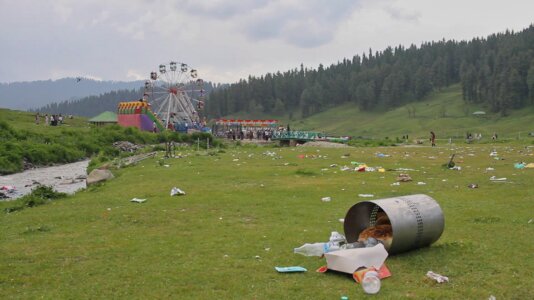Unease in Bangus Valley: Concrete Structure Raises Concerns About Development
By: Javid Amin
The once-pristine Bangus Valley in Kashmir is facing a potential turning point. The recent discovery of a concrete structure has sparked worry and debate among locals and environmental advocates. Many fear this might be the first step towards a wave of construction projects that could forever alter the valley’s natural beauty and serene character.
A Valley Untouched
Nestled in the Kupwara district of Kashmir, Bangus Valley boasts a breathtaking landscape. Lush green meadows, dense forests, and sparkling streams create a picture of untouched nature. The valley has recently gained popularity as an off-the-beaten-path tourist destination, attracting visitors seeking tranquility and escape from the urban bustle.
A Concrete Intrusion
The recent discovery of a concrete structure within the valley has cast a shadow of uncertainty over its future. Details about the structure, its purpose, and who is behind its construction remain unclear. However, the sight of concrete amidst the natural landscape has been enough to stir a sense of unease among locals and environmental activists.
Concerns and Apprehensions
The primary concern is that this structure might be a harbinger of large-scale development projects. Locals fear that the valley’s natural beauty and serene environment, which are the very reasons for its growing popularity, could be sacrificed in the name of commercialization.
- Loss of Natural Beauty: Uncontrolled construction projects could lead to deforestation, destruction of meadows, and disruption of the valley’s delicate ecosystem. The visual appeal of the landscape, a key factor in attracting tourists, would be significantly compromised.
- Environmental Impact: Construction activities often involve pollution, soil erosion, and disruption of natural water channels. This can damage the fragile ecological balance of the valley and have lasting consequences on flora and fauna.
- Unsustainable Tourism: Large-scale development could transform Bangus Valley into a commercial tourist destination, leading to overcrowding and strain on resources. This can ultimately harm the very experience tourists seek and contribute to environmental degradation.
A Call for Sustainable Development
The discovery of the concrete structure has ignited a debate about the future of Bangus Valley. Many are calling for a more sustainable approach to development that prioritizes the preservation of the valley’s natural beauty. Here are some potential solutions:
- Community Involvement: Locals and environmental groups should be actively involved in any development plans for the valley. Their voices and concerns should be heard and addressed to ensure a balanced approach.
- Eco-Friendly Practices: Any construction activities within the valley should adhere to strict environmental regulations and utilize eco-friendly practices. Sustainable materials and techniques can minimize the ecological footprint of development projects.
- Focus on Eco-Tourism: Promoting eco-tourism can be a viable solution that benefits both the local economy and the environment. Tourists can be encouraged to appreciate and respect the valley’s natural beauty while participating in activities that have minimal impact.
- Preservation Efforts: Strong regulations are needed to protect Bangus Valley from uncontrolled development. Establishing the valley as a protected area can help ensure its natural beauty is preserved for future generations.
Looking Ahead: Balancing Progress and Preservation
The future of Bangus Valley hangs in the balance. The recent discovery of the concrete structure has served as a wake-up call. It’s a critical juncture where a conscious decision needs to be made. Can the valley be developed in a way that respects its natural heritage and caters to responsible tourism, or will it succumb to unchecked construction and lose its very essence? The answer lies in a collaborative effort between the local community, environmental organizations, and the government to chart a course for sustainable development that prioritizes both economic progress and environmental preservation.


